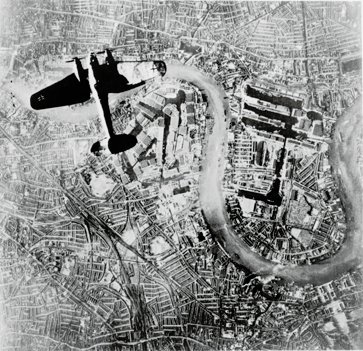An alternative Battle of Britain -- III

He 111 over London, 7 September 1940. Image source: Wikimedia Commons.
So, I've looked at J. M. Spaight's predictions in The Sky's the Limit about how the British fighters would fare in the Battle of Britain, and how the German ones would too. All that remains is to examine his thoughts on the German bombers.
These are (sadly!) less surprising than his claims for the fighters. He gives pride of place to the He 111, which he classifies as a heavy bomber comparable to the RAF's Wellington. According to Spaight, the He 111 had sound structural design and was well manufactured, and he admitted that its bullet-proof fuel tanks and fuel injection systems were advantages the Wellington lacked. He quoted the verdict of The Aeroplane:
There is no doubt that the Wellington is far more efficient as a fighting machine and capable of giving a much better account of itself against enemy fighters. Taken all round, the Wellington is the much better aeroplane, with greater range, defence and bomb-load achieved on less power, with only slightly less speed.1
This is a pretty fair judgement. The Wimpy's defensive armament was superior, with 6 machine guns in power turrets and 2 in waist positions, to the Heinkel's 5-7 manually-aimed machine guns. But neither was adequately armed for defence against fighters, which was the really important comparison.
German"reconnaissance" bombers mentioned by Spaight include the very robust Do 17 (the famous Dornier"flying pencil") and the Do 215 (actually an export variant of the Do 17, which actually didn't see much service with the Luftwaffe). Again, he compares them with their nearest British equivalent, in this case the Blenheim IV. Again, this is not a particularly useful comparison. The Blenheim may have been 'undoubtedly a much more unpleasant machine to meet than the Do 215',2 but this situation was unlikely to arise for British fighters.3
After swiftly (and quite fairly) dismissing the famed Ju 87 Stuka (short ranged, small bombload, very vulnerable to fighters), Spaight notes the introduction of a new German bomber, the Ju 88 -- as it turned out, the best bomber deployed by the Luftwaffe in 1940:
Recently the Germans have been making increasing use, especially for raids against shipping, of Junkers Ju 88 bombers ... At 300 miles an hour its range is over 1,200 miles, and with full military load its speed is understood to be 265 miles an hour and its range about 1,300 miles.4
'[E]vidently a formidable machine', he goes on to say, `but [it] would be completely outclassed, for speed, by our Spitfire'. 5 So at last, Spaight is properly comparing apples with oranges -- and reassuringly, the RAF comes up trumps once more.
Spaight argues that the old dogma that 'the bomber will always get through' no longer holds. It may have been true when Douhet, Baldwin and others uttered it, when bombers were almost as fast and as well-armed as fighters. But the Spanish Civil War showed that things had changed:
In Spain the fighter pilot began to come into his own. Even when the comparatively slow and moderately biplane fighters were in use in the earlier part of the war they proved themselves to be dangerous enemies to the bombers. The later fighters, the multi-gun monoplanes of high speed, were still more formidable opponents ... Even before the present war the doctrine that"the bomber will always get through" had been recognised in this country for the half-truth that it was.6
The experience of Bomber Command in late 1939 backed this up, when Wellingtons attacking German naval bases were severely mauled by defending fighters. Spaight speculated that in future, fighters might tend towards the larger, twin-engined types (like the Me 110 or Fw 187), so that they could carry more armour, heavier guns and more ammunition. Conversely, bombers might well become smaller, as heavy bombers appeared too slow and vulnerable to fighters.
The result may well be that the bomber and the fighter will tend to approximate to one another in size and that the one class will overlap the other. This tendency is to be seen already in our own Blenheims, which can be used alternatively as bomber-reconnaissance or as fighter-machines.7
This didn't happen, but there was some convergence in the form of fighter-bombers like the Typhoon. Heavies remained in use (and only got heavier), but their vulnerability to fighters was addressed by attacking at night or providing fighter escorts with drop tanks.
So, to sum up finally, what can we say from all of this? That the future is uncertain is a given; that the present is also is perhaps less easy to appreciate. Spaight was wrong on many points, but he generally had reasonable grounds for being so. However, one suspects that the way that British aircraft always turn out to be superior to their German opponents was not necessarily grounded in sober analysis, but rather in a desire to prop up morale. After all, this book as aimed at a popular audience, and was updated and reprinted at a time when it appeared that Britain's future depended upon air defence. It's hardly surprising, therefore, if Spaight decided to forego his usual judicious sifting of the evidence and told his readers what he thought they needed to hear. The pre-war fear of the bomber was a liability in 1940. Only in 1944, when the Combined Bomber Offensive was pounding targets in Axis-controlled Europe around the clock, did Spaight find it expedient to reverse his position once more in his apologia Bombing Vindicated.
- The Aeroplane, 5 January 1940; quoted in J. M. Spaight, The Sky's the Limit (London: Hodder and Stoughton, 1940), 62.
- Spaight, The Sky's the Limit, 64.
- Except, of course, when Blenheims were mistaken for German bombers and bounced by RAF fighter patrols!
- Spaight, The Sky's the Limit, 65.
- Ibid., 65.
- Ibid., 106-7.
- Ibid., 72-3.